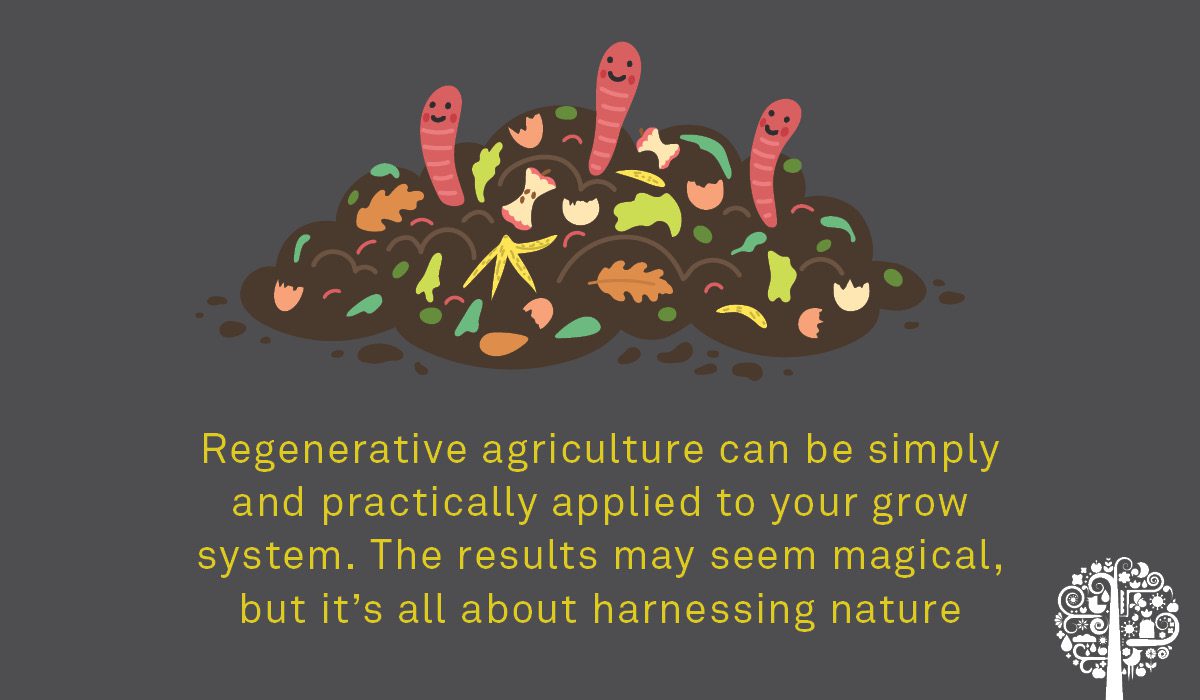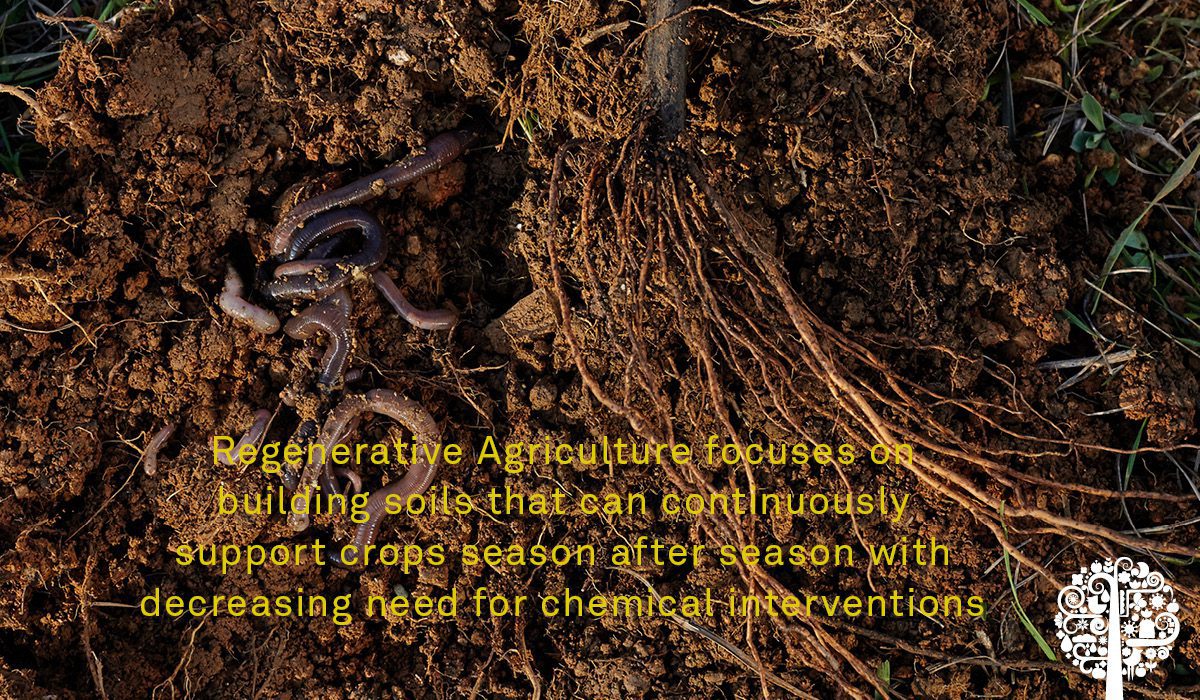Hack an aspen tree down to its stump, and within weeks, it will regenerate new limbs. But strip away the soil beneath it, and it could take thousands of years before it can support that same tree. Nature paints a portrait of resilience. Regenerative Agriculture focuses on building soils that can continuously support crops season after season with decreasing need for chemical interventions.
Regenerative Agriculture draws on two terms with deep meaning:
re·gen·er·a·tive /rəˈjen(ə)rədiv/
To replace (a body part) by new growth. To become formed again. To produce again chemically. To produce anew.
ag·ri·cul·ture /ˈaɡrəˌkəlCHər/
The science or practice of farming, including cultivation of the soil for the growing plants to provide food, medicine, and other products.
The word regenerative is aspiring and inspiring. Just as the Aspen tree sprouts new limbs from a decapitated stump, we can rebuild our depleted soils and revive agriculture-focused communities around a shared mission to enhance cultivators’ livelihoods, environmental health, and food quality.

Regenerative agriculture emerged from cultivator-led efforts to restore degraded farm soils with an eye towards biodiversity, water efficiency, and soil microbes to renew soil fertility. Interest in this topic has exploded as innovative and enthusiastic cultivators have shared their practices and outcomes through social media, books, and events.
Four fundamental principles ground regenerative agriculture:
- Reducing disturbance of the soil
- Keeping the soil covered with plants throughout the year
- Minimizing chemical inputs
- Increasing plant and soil biodiversity
By maximizing soil health, crop yields increase while the necessity for intensive management and inputs decreases. Historic regenerative practices include no-till, cover crops, and the integration of animals into cropping systems. These techniques often emulate and borrow from complex and sustainable agricultural practices developed by Indigenous communities long ago.
Some may see regenerative agriculture as a step back in time. A few decades ago, it was common to see complex farming operations growing many crops and animals in an integrated system. But, in just the last several decades, we have lost up to half of our topsoil as farms became larger and more productive but also less diverse and resilient. This is a critical problem because as soils continue to degrade, so will crop production. While the reemergence of regenerative agriculture often focuses on practices like crop-livestock integration and cover crops, cutting-edge biological technologies can also accelerate soil health and ecosystem recovery, thus reducing the need for chemical fertilizer and pesticide applications. These nature-focused modern technologies can be integrated over time as very sustainable, efficient, and profitable tools.

The scientific understanding of the benefits that regenerative agriculture offers to growers is also quickly advancing. Recent studies have shown that rapid soil carbon buildup under intensively managed grazing systems leads to improved soil fertility and crop productivity. They have shown that compost additions can stimulate beneficial biological activity in soils while suppressing soil-borne pathogens. These benefits indicate the resilience and longevity that regenerative agriculture creates in farming systems by developing healthy soils.
Across a broad range of agricultural production systems, growers are looking for new ways to incorporate regenerative principles in their operations. These simple, nature-focused principles can be adapted into all management practices, including indoor agriculture.
Q: Why should commercial and home growers consider adopting regenerative agriculture practices for indoor production?
A: The time and energy you put towards implementing regenerative practices into your cultivation system will lead to great returns by maximizing your plants’ health and quality (flavor, resin, and potency) while reducing the need for strict feeding and pesticide regimes.
Some simple steps allow you to bridge the gap between implementing regenerative agriculture practices into your growing system. However, the first step is developing the mindset of growing soil, not plants! Cultivators that successfully integrate regenerative agriculture practices into their management will focus on activities that build soil fertility and biology to support plant growth. Once you make healthy soil, your plants will grow to their maximum potential with ease.
The learning curve on your regenerative agriculture journey may be steep initially. Thus, we recommend a gradual approach to regenerative principles with some simple actions that are easy to adopt.

First, let’s talk composting. Composting uses natural microbes to break down organic waste into a rich organic material that is the foundation of soil health. With the right combination of carbon, nitrogen, water, and oxygen, the microbes get to work. You can use finished compost as a top dressing and as a transplant mix to feed your plants. The simple thing about composting is that you can throw leaf clippings and food scraps into a pile, and they will decompose into nutrient-rich compost for your garden. Let’s put our waste to work for us!
The three main ingredients for successful composting – microbes, oxygen, and moisture – are the recipe for success:
- Soil microbes facilitate the composting process. Using soil inoculants is a great way to kick start the process. You can use products on the shelf or grab some soil from your yard to add to the mix – your call!
- Microbes need oxygen to do their job. Turning the materials in your pile over once a week will add just enough air. You can also aerate the compost pile by poking it with a pitchfork. If your compost pile smells like ammonia, it has gone anaerobic, and this is a sign that it needs to be turned.
- Adequate moisture is the third essential component. This is simple – just water it. Note: your compost pile should be moist like a damp sponge, not saturated or soggy.
At maximum, a compost pile should be no larger than 1m x 1m x 1m. Either use a barrel or wood box as a container to hold your compost.
Quick tip #1:
Barrels work great as a container for easily turning the compost simply by rolling the barrel a quarter turn every week. Also, the more you shred the material, the quicker it will decompose. Depending on the size of your compost pile, the composting process can take three months to two years, so planning ahead (so you’ll regularly have finished compost to incorporate into your growing system) is the first major hurdle you’ll encounter on your regenerative agriculture journey.
Quick tip #2:
Word of warning – don’t use compost before it is ready, or it can be very messy!
After you have dialed in this primary tool on how to build soil – we must use it! This is where the learning curve kicks in.
Q: How many nutrients will you deliver to your plants?
A: It depends on your compost! You can measure it by simply measuring the nutrients. This can be accomplished initially by using a soil testing lab. Local universities can test the soil, and several private companies also perform these services. Once you understand the N:P:K concentration of your compost, you can start regularly monitoring onsite using a PPM meter. For compost, growers can make a 10:1 (water to compost) slurry in a small cup and measure the ppm of the slurry.
Q: Do you need supplemental nutrients?
A: At first, it is likely, but over time you will be able to rely heavily on the nutrients provided by the compost and become less dependent on other nutrient inputs. And get this – different composting inputs will yield different results. You must become a master at understanding the best inputs for your compost. This will lead you to become a master at growing soil.
After you have mastered the use of composting as a fertility source to grow your soil, your next steps should consider using raised bed, introducing natural predators and natural products for pest management, and rotational and companion plant cropping.
By adopting regenerative agriculture principles, you can develop a soil system that will grow the best quality product. Once one has experienced a quality that overshadows all others, a new standard is set, and people will do whatever is in their means to experience that quality again. This is not easy, but one step at a time, regenerative agriculture can be simply and practically applied to your grow system. The results may seem magical, but it’s all about harnessing nature.